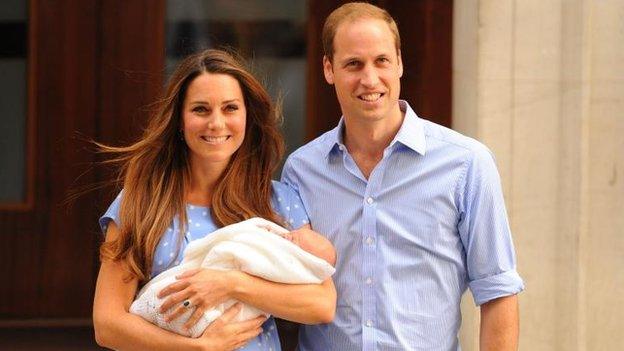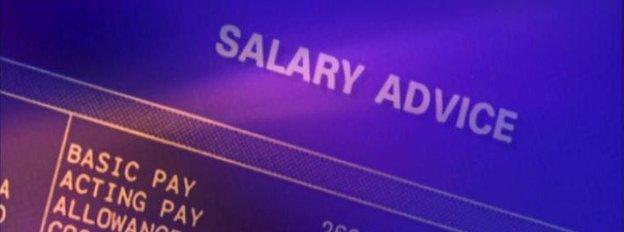How the UK's new rules on parental leave work
- Published

Parents who are expecting a baby from now will be able to share leave
New rights allowing UK parents to share leave following the birth or adoption of their child have come into effect.
Up to 50 weeks of leave - 37 weeks of which is paid - can be shared by parents if they meet certain eligibility criteria.
The TUC has argued that many parents will not qualify for the new rights and some employers' groups have criticised the greater complexity now facing businesses.

What are the basics of these new rules?

Traditionally, it has only been an option for a mother to take paid time off work to look after a newborn.
Now, most couples who are in paid work and bringing up a child together can share leave following the birth or adoption of their child.
Parents can take leave in their child's first year at different times, or double up by taking leave at the same time.
The rights apply to parents in work, including those who are adopting, same-sex couples, co-habiting couples, and couples bringing up a child together even if the baby is from a previous relationship.

Does this change regular maternity and paternity leave?
Not greatly. Fathers will still be entitled to two weeks of paid paternity leave. The new rules replace "additional paternity leave".
Mums can take maternity leave under existing rules.
Mothers must still take the initial two weeks after birth, but they can then cut their maternity leave short and exchange it for shared parental leave.
Both parents will then have a flexible choice of how to split up the rest of the leave entitlement - of up to 50 weeks.
For example, if a mother ends her maternity leave after the 12 weeks following the child's birth, that leaves 40 weeks of leave. She chooses to take 30 weeks and so her partner can take the other 10 weeks. Alternatively, the couple may choose to take 20 weeks of leave at the same time or at different times.

Can parents take leave when they want?

New flexibility means that shared parental leave does not have to be taken all in one go.
A parent can book up to three blocks of leave in the course of the child's first year. They must give their employer at least eight weeks notice before taking leave.
An employer may agree to shorter blocks of leave, of just a week or more, but that is up to them.
A mother who wants such flexibility can take her leave as shared parental leave - even if the father takes none of it - rather than traditional maternity leave.
A mother can also let her employer know before her baby is born that she doesn't plan to use all of her 52 weeks' maternity leave and wants to convert some of it into shared parental leave. Her partner could then use this leave to help out in the first few weeks after birth while she is still on maternity leave.

Why aren't all parents eligible?
This is where it gets a little more complicated.
To take shared leave, one parent must have been an employee with at least 26 weeks of service with the same employer by the end of the 15th week before the baby is due, or when matched with an adopted child.
The other must have worked for at least 26 weeks in the 66 weeks leading up to the due date and have earned at least £30 a week in 13 of the 66 weeks.
Got it. Well, there are caveats. For example, the self-employed, and a parent not in work at the time of the birth can still qualify.

How much will parents be paid?

Shared parental leave pay is £139.58 a week or 90% of an employee's average weekly earnings, whichever is lower. There is a possibility that an employer may offer more.
This is the same as statutory maternity pay, except that during the first six weeks statutory maternity pay amounts to 90% of whatever the employee earns, with no maximum.
Shared parental pay is only given for 37 weeks. The remaining 13 weeks of leave entitlement, if taken, is unpaid.

Are there any potential knock-on effects over pay?
Some mothers receive full pay during their maternity leave, rather than the statutory minimum.
Lawyers have suggested that some employers may worry that dads, taking shared parental leave, could bring discrimination claims if the extra pay was not offered to them too. As a result, lawyers say some employers may stop giving mums this enhanced pay.
Some mums moving from maternity to shared parental leave may not receive full pay. The details should be in an employment contract.
However, the Civil Service says it will give full parental pay to fathers, as well mothers, taking shared parental leave.

Is everyone happy with these new rules?

From 2011 to now, fathers have been entitled to extended paid paternity leave, called additional paternity leave. Shared parental leave rules will replace this, but concerns have been raised that only a fraction of new fathers had taken the opportunity of longer paternity leave.
On behalf of employees, the TUC says that two in five fathers in work will not be eligible for shared parental leave, mainly because their partner is not in paid work.
Speaking for employers, the Institute of Directors and the Federation of Small Businesses, say that many companies, particularly smaller firms, will find it difficult to deal with the complexity of the new arrangements.

Where can I go for more detail?
There is plenty of help for new parents and employers trying to understand and make the most of the new rules.
The government's official website Gov.uk has a section on shared parental leave, external, including details for new parents, external, a pay and leave calculator, external, a selection of forms to download, external when applying for the leave, and a guide for employers, external.
The conciliation service Acas also has a guide for employers and employees, external.
- Published30 March 2015

- Published24 March 2014
